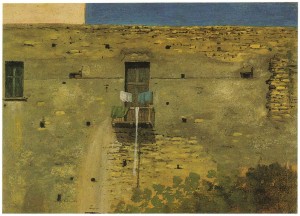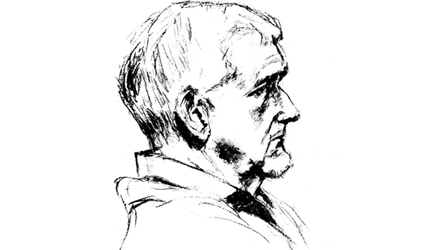When your preconception about something you are looking at is suddenly and completely overturned, the experience is memorable. This happened to me in The National Gallery in London a few years ago.
PLEASE CLICK ON THE BUTTON ABOVE TO HEAR THIS POEM

The proof that less is more –
a snatched oil sketch, postcard size
predominantly yellowed-grey
surmounted by a thin blue strap
abutting a cream corner block
 – perhaps a sixties abstract but
– perhaps a sixties abstract but
with its own warm light source.
Yet look again, a door and window
have their modest elevated place
within now what clearly is a wall,
crumbly, the plaster mostly peeled
but nearly filling the entire tiny scene.
A precursive Pollack fig tree
suggests welcome shade, lower right.
The only human interest dangles
before the door, a length of lace,
static, with three drying cloths.
Around this tiny theatre of the balcony
square black marks emerge.
Were they the fixing points
for a portico and long-vanished steps?
Did their pocked mystery cause
Thomas Jones from Pencerrig to pause,
look again, then create en plein air
eighty years before Monet and Manet
and another sixty before Mondrian
a post card to them all
on the ‘supremacy of pure feeling’*
from Naples, in about 1782.
A Wall in Naples by Thomas Jones, about 1782, can be seen in The National Gallery.
